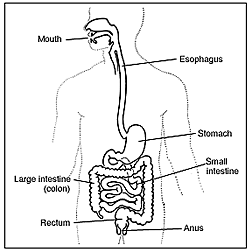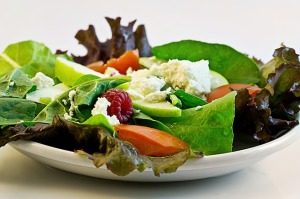
Without exception – everyone has gas and normally they eliminate it by burping or passing it through the rectum. However, many people think they have too much gas when they really have normal amounts. Most people produce about 1 to 2 litres a day and pass gas about 10 – 15 times a day.
Gas is made primarily of odourless vapours—carbon dioxide, oxygen, nitrogen, hydrogen, and sometimes methane. The smelly, rather unpleasant, odour of flatulence comes from bacteria in the large intestine that release small amounts of gases that contain sulphur.
Although having gas is common, it can be uncomfortable and embarrassing. Understanding causes, ways to reduce symptoms, and treatment will help most people find relief.
What causes gas?
Gas in the digestive tract (that is, the oesophagus, stomach, small intestine, and large intestine) comes from two sources:
- swallowed air (you ‘eat’ more than you think you do)
- normal breakdown of certain undigested foods by harmless bacteria naturally present in the large intestine (colon)[private_silver]
Swallowed Air
Air swallowing (aerophagia) is a common cause of gas in the stomach. Everyone swallows small amounts of air when eating and drinking. However, eating or drinking rapidly, chewing gum, smoking, or wearing loose dentures can cause some people to take in more air.
Burping, or belching, is the way most swallowed air — which contains nitrogen, oxygen, and carbon dioxide — leaves the stomach. The remaining gas moves into the small intestine, where it is partially absorbed. A small amount travels into the large intestine for release through the rectum. (The stomach also releases carbon dioxide when stomach acid and bicarbonate mix, but most of this gas is absorbed into the bloodstream
and does not enter the large intestine.)
Breakdown of Undigested Foods
The body does not digest and absorb some carbohydrates (the sugar, starches, and fiber found in many foods) in the small intestine because of a shortage or absence of certain enzymes.
Another reason is that the modern diet encourages us to eat too much refined food and so we overload our digestive system.
What you don’t digest properly you eliminate in one form or another – and that may be gas…
This undigested food then passes from the small intestine into the large intestine, where normal, harmless bacteria break down the food, producing hydrogen, carbon dioxide, and, in about one-third of all people, methane. Eventually these gases exit through the rectum.
People who make methane do not necessarily pass more gas or have unique symptoms. A person who produces methane will have stools that consistently float in water. Research has not shown why some people produce methane and others do not.
Foods that produce gas in one person may not cause gas in another. Some common bacteria in the large intestine can destroy the hydrogen that other bacteria produce. The balance of the two types of bacteria may explain why some people have more gas than others.
Which foods cause gas?
Most foods that contain carbohydrates can cause gas. By contrast, and good news for LowCarbers is the fact that fats and proteins cause little gas.
Sugars
The sugars that cause gas are raffinose, lactose, fructose, and sorbitol.
Raffinose
Beans contain large amounts of this complex sugar. Smaller amounts are found in cabbage, brussels sprouts, broccoli, asparagus, other vegetables, and whole grains.
Lactose
Lactose is the natural sugar in milk. It is also found in milk products, such as cheese and ice cream, and processed foods, such as bread, cereal, and salad dressing. Many people, particularly those of African, Native American, or Asian background, normally have low levels of the enzyme lactase needed to digest lactose after childhood. Also, as people age, their enzyme levels decrease. As a result, over time, people may experience
increasing amounts of gas after eating food containing lactose.
Fructose
Fructose is naturally present in onions, artichokes, pears, and wheat. It is also used as a sweetener in some soft drinks and fruit drinks.
Sorbitol
Sorbitol is a sugar found naturally in fruits, including apples, pears, peaches, and prunes. It is also used as an artificial sweetener in many dietetic foods and sugarfree candies and gums.
Starches
Most starches, including potatoes, corn, noodles, and wheat, produce gas as they are broken down in the large intestine. Rice is the only starch that does not cause gas.
Fiber
Many foods contain soluble and insoluble fiber. Soluble fiber dissolves easily in water and takes on a soft, gel-like texture in the intestines. Found in oat bran, beans, peas, and most fruits, soluble fiber is not broken down until it reaches the large intestine, where
digestion causes gas.
Insoluble fiber, on the other hand, passes essentially unchanged through the intestines and produces little gas. Wheat bran and some vegetables contain this kind of fiber.
What are some symptoms and problems of gas?
The most common symptoms of gas are flatulence, abdominal bloating, abdominal pain, and belching. However, not everyone experiences these symptoms. The determining factors probably are how much gas the body produces, how many fatty acids the body absorbs, and a person’s sensitivity to gas in the large intestine.
Belching
An occasional belch during or after meals is normal and releases gas when the stomach is full of food. However, people who belch frequently may be swallowing too much air and releasing it before the air enters the stomach.
Sometimes a person with chronic belching may have an upper GI disorder, such as peptic ulcer disease, gastroesophageal reflux disease (GERD), or gastroparesis.
Occasionally, some people believe that swallowing air and releasing it will relieve the discomfort of these disorders, and this person may intentionally or unintentionally develop a habit of belching to relieve discomfort.
Gas-bloat syndrome may occur after fundoplication surgery to correct GERD. The surgery creates a one-way valve between the oesophagus and stomach that allows food and gas to enter the stomach but often prevents normal belching and the ability to vomit. It occurs in about 10 percent of people who have this surgery but may improve with time.
Flatulence
Another common complaint is passage of too much gas through the rectum (flatulence). However, most people do not realize that passing gas 14 to 23 times a day is normal. Too much gas may be the result of carbohydrate malabsorption.
Abdominal bloating
Many people believe that too much gas causes abdominal bloating. However, people who complain of bloating from gas often have normal amounts and distribution of gas. They actually may be unusually aware of gas in the digestive tract.
Doctors believe that bloating is usually the result of an intestinal disorder, such as irritable bowel syndrome (IBS). The cause of IBS is unknown, but may involve abnormal movements and contractions of intestinal muscles and increased pain sensitivity in the intestine. These disorders may give a sensation of bloating because of increased
sensitivity to gas.
Any disease that causes intestinal inflammation or obstruction, such as Crohn’s disease or colon cancer, may also cause abdominal bloating. In addition, people who have had many operations, adhesions (scar tissue), or internal hernias may experience bloating or pain.
Finally, eating a lot of fatty food can delay stomach emptying and cause bloating and discomfort, but not necessarily too much gas.
Abdominal Pain and Discomfort
Some people have pain when gas is present in the intestine. When pain is on the left side of the colon, it can be confused with heart disease. When the pain is on the right side of the colon, it may mimic gallstones or appendicitis.
What diagnostic tests are used?
Because gas symptoms may be caused by a serious disorder, those causes should be ruled out. The doctor usually begins with a review of dietary habits and symptoms. The doctor may ask the patient to keep a diary of foods and beverages consumed for a specific time period.
If lactase deficiency is the suspected cause of gas, the doctor may suggest avoiding milk products for a period of time. A blood or breath test may be used to diagnose lactose intolerance.
In addition, to determine if someone produces too much gas in the colon or is unusually sensitive to the passage of normal gas volumes, the doctor may ask patients to count the number of times they pass gas
Careful review of diet and the amount of gas passed may help relate specific foods to symptoms and determine the severity of the problem.
Because the symptoms that people may have are so variable, the physician may order other types of diagnostic tests in addition to a physical exam, depending on the patient’s symptoms and other factors.
How is gas treated?
Experience has shown that the most common ways to reduce the discomfort of gas are changing diet, taking medicines, and reducing the amount of air swallowed.
Diet
Doctors may tell people to eat fewer foods that cause gas. Which is an obvious first step.
Obviously, foods you’re sensitive too would be a good second step although, for some people this may mean cutting out foods such as fruits and vegetables, milk products, and others.
Some doctors may also suggest limiting high-fat foods to reduce bloating and discomfort. This helps the stomach empty faster, allowing gases to move into the small intestine.
Unfortunately, the amount of gas caused by certain foods varies from person to person. Effective dietary changes depend on learning through trial and error how much of the offending foods one can handle.
The most effective method is to move to a high protein diet – most LowCarb regimes will work although your body my be more suited to one more than another.
Nonprescription Medicines
Although we would not recommend it, some health professionals may suggest using nonprescription, over-the-counter medicines that are available to help reduce symptoms, including antacids with simethicone. Digestive enzymes, such as lactase supplements, actually help digest carbohydrates and may allow people to eat foods that normally cause gas.
Antacids, such as Mylanta II, Maalox II, and Di-Gel, contain simethicone, a foaming agent that joins gas bubbles in the stomach so that gas is more easily belched away. However, these medicines have no effect on intestinal gas. Dosage varies depending on the form of medication and the patient’s age.
The enzyme lactase, which aids with lactose digestion, is available in caplet and chewable tablet form without a prescription (Lactaid and Lactrase). Chewing lactase tablets just before eating helps digest foods that contain lactose. Also, lactose-reduced milk and other products are available at many grocery stores (Lactaid and Dairy Ease).
Beano, an over-the-counter digestive aid, contains the sugar-digesting enzyme that the body lacks to digest the sugar in beans and many vegetables. The enzyme comes in liquid and tablet form. Five drops are added per serving or 1 tablet is swallowed just before eating to break down the gas-producing sugars. Beano has no effect on gas caused by lactose or fiber.
Prescription Medicines
Doctors may prescribe medicines to help reduce symptoms, especially for people with a disorder such as IBS.
Reducing Swallowed Air
Those who have chronic belching should find ways to reduce the amount of air swallowed. Recommendations are to avoid chewing gum and to avoid eating hard candy. Eating at a slow pace and checking with a dentist to make sure dentures fit properly should also help.
Conclusion
Although gas may be uncomfortable and embarrassing, it is not life-threatening. Understanding causes, ways to reduce symptoms, and treatment will help most people find some relief.
But you should take note of it, as it is a sure sign that what you’re eating is not totally suited to what your body wants.
Points to remember
- Everyone has gas in the digestive tract.
- People often believe normal passage of gas to be excessive.
- Gas comes from two main sources: swallowed air and normal breakdown
of certain foods by harmless bacteria naturally present in the large intestine.
- Many foods with carbohydrates can cause gas. Fats and proteins cause little gas.
- Foods that may cause gas include
- beans
- vegetables, such as broccoli, cabbage, brussels sprouts, onions, artichokes, and asparagus
- fruits, such as pears, apples, and peaches
- whole grains, such as whole wheat and bran
- soft drinks and fruit drinks
- milk and milk products, such as cheese and ice cream, and packaged
foods prepared with lactose, such as bread, cereal, and salad dressing
- foods containing sorbitol, such as dietetic foods and sugarfree candies and gums
- The most common symptoms of gas are belching, flatulence, bloating, and abdominal pain. However, some of these symptoms are often caused by an intestinal disorder, such as irritable bowel syndrome, rather than too much gas.
- The most common ways to reduce the discomfort of gas are changing diet, taking non-prescription medicines, and reducing the amount of air swallowed.
- Digestive enzymes, such as lactase supplements, actually help digest carbohydrates and may allow people to eat foods that normally cause gas. [/private_silver]


 Without exception – everyone has gas and normally they eliminate it by burping or passing it through the rectum. However, many people think they have too much gas when they really have normal amounts. Most people produce about 1 to 2 litres a day and pass gas about 10 – 15 times a day.
Without exception – everyone has gas and normally they eliminate it by burping or passing it through the rectum. However, many people think they have too much gas when they really have normal amounts. Most people produce about 1 to 2 litres a day and pass gas about 10 – 15 times a day.